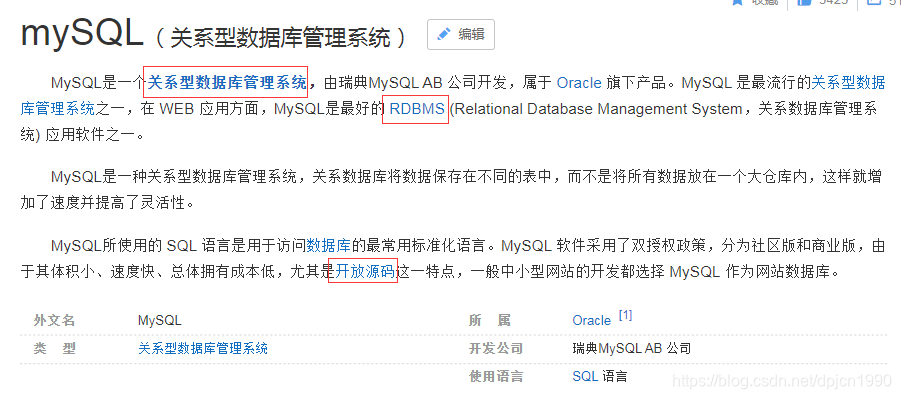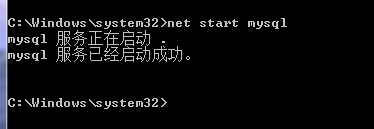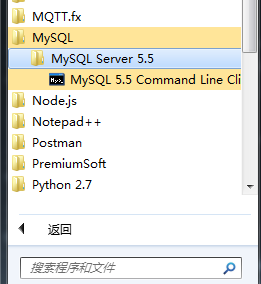1、什么是MySql?

截取自百度百科 。
互联网时代,我们都是在跟数据打交道,例如:
- 天猫淘宝上热卖产品,个人历史订单
- 微信朋友圈聊天记录
- 手机本地通信录
- …
可以毫不夸张地说,只要涉及到互联网,始终离不开数据。
那么数据就得有地方去存放,并且是持久化存放(总不能全部数据直接加载在内存中,然后断电GG)。
并且为了快速查询到我们需要的数据(一些大系统数据库至少过T,总不能全库扫描),那么总得有一个系统去帮我们做这件事情。
那么就得有一个系统能满足以下两点要求:
持久化存储(硬盘文件系统)快速查询目标数据(也叫做快速索引,那么就意味着我们的数据肯定处于某种有效的组织中 —— 从算法角度来说,就是数据结构,举个例子:教育局为了管理学生资料,给每一个学生分配一个唯一的学号,通过学号来找到每个学生)
能满足以上两个条件的系统就是我们常说的数据库管理系统(DataBase Manager System,DBMS),在DBMS下管理着数据库(DataBase,DB),最终我们通过SQL(
结构化查询语言
Structured query language)来对数据库进行CURD(增删改查)。
注意:我们常说数据库,其实指的是整个数据库管理系统,包括DBMD和DB。
在众多的数据库管理系统中,最受大众喜欢也是目前绝大部分公司都在使用的就是MySQL(开源、免费,意味着接入成本低),这也是我们为什么要学习它的原因。
2、安装MySql
Mysql采用C-S架构,也就是Client-Server,所以我们首先需要安装 MySql Server。
2.1 下载地址
2.2.1 下载地址1 —— 可以下载免安装版本
https://dev.mysql.com/downloads/mysql/

习惯性我比较喜欢后退两个版本(说白了就是求稳)。
比如说,我这里下载 5.6.49版本(这个是免安装版本):

点击Download

静静等待下载成功。
如果你还是下载不了,那么我也上传到了CSDN,免积分下载,请点击
2.1.2 下载地址2 —— 下载MSI文件(推荐这种方式。。。)
http://mirrors.sohu.com/mysql/MySQL-5.5/?C=S&O=A

我这里下载了 mysql-5.5.60-winx64.msi 这个文件、
如果你还是下载不了,那么我也上传到了CSDN,免积分下载,请点击
2.2 推荐安装步骤 —— 针对下载方式2
2.2.1 安装 mysql-5.5.60-winx64.msi —— 图片讲解,认真看好每一步
-
点击 mysql-5.5.60-winx64.msi ,弹出界面,点击Next

-
勾选 I accept the terms in the License Agreement,点击 Next

-
选择需要的构建类型,这里我们选择custom


点击 Next

-
点击 install,进行安装

安装成功

到这一步我们仅仅是安装好了环境,但是还没有进行配置。
我们来看看一下安装目录 C:\Program Files\MySQL\MySQL Server 5.5:

一般熟悉win应用程序的人来说,我们会更关注bin目录(因为一般执行命令都是在里面):

先了解到这里,点击 Finish,进行下一步的配置。
2.2.2 配置MySQL
- 点击 Finish,正常情况会弹出这个页面

如果不小心关闭了,那么也可以通过bin命令来调起:

-
点击 Next,选择Detailed Configuration

-
选择服务类型

-
选择数据库类型


点击Next -
设置并发数,默认点击Next

-
设置MySql的端口号,默认即可,点击next

-
设置默认字符集

-
设置windows上的选项

-
配置MySql Server的安全选项(账号密码)

-
配置完毕,点击执行,等待配置成功


2.2.3 查看配置(可忽略)

使用记事本打开,可以看到以下内容:
# MySQL Server Instance Configuration File
# ----------------------------------------------------------------------
# Generated by the MySQL Server Instance Configuration Wizard
#
#
# Installation Instructions
# ----------------------------------------------------------------------
#
# On Linux you can copy this file to /etc/my.cnf to set global options,
# mysql-data-dir/my.cnf to set server-specific options
# (@localstatedir@ for this installation) or to
# ~/.my.cnf to set user-specific options.
#
# On Windows you should keep this file in the installation directory
# of your server (e.g. C:\Program Files\MySQL\MySQL Server X.Y). To
# make sure the server reads the config file use the startup option
# "--defaults-file".
#
# To run run the server from the command line, execute this in a
# command line shell, e.g.
# mysqld --defaults-file="C:\Program Files\MySQL\MySQL Server X.Y\my.ini"
#
# To install the server as a Windows service manually, execute this in a
# command line shell, e.g.
# mysqld --install MySQLXY --defaults-file="C:\Program Files\MySQL\MySQL Server X.Y\my.ini"
#
# And then execute this in a command line shell to start the server, e.g.
# net start MySQLXY
#
#
# Guildlines for editing this file
# ----------------------------------------------------------------------
#
# In this file, you can use all long options that the program supports.
# If you want to know the options a program supports, start the program
# with the "--help" option.
#
# More detailed information about the individual options can also be
# found in the manual.
#
#
# CLIENT SECTION
# ----------------------------------------------------------------------
#
# The following options will be read by MySQL client applications.
# Note that only client applications shipped by MySQL are guaranteed
# to read this section. If you want your own MySQL client program to
# honor these values, you need to specify it as an option during the
# MySQL client library initialization.
#
[client]
port=3306
[mysql]
default-character-set=utf8
# SERVER SECTION
# ----------------------------------------------------------------------
#
# The following options will be read by the MySQL Server. Make sure that
# you have installed the server correctly (see above) so it reads this
# file.
#
[mysqld]
# The TCP/IP Port the MySQL Server will listen on
port=3306
#Path to installation directory. All paths are usually resolved relative to this.
basedir="C:/Program Files/MySQL/MySQL Server 5.5/"
#Path to the database root
datadir="C:/ProgramData/MySQL/MySQL Server 5.5/Data/"
# The default character set that will be used when a new schema or table is
# created and no character set is defined
character-set-server=utf8
# The default storage engine that will be used when create new tables when
default-storage-engine=INNODB
# Set the SQL mode to strict
sql-mode="STRICT_TRANS_TABLES,NO_AUTO_CREATE_USER,NO_ENGINE_SUBSTITUTION"
# The maximum amount of concurrent sessions the MySQL server will
# allow. One of these connections will be reserved for a user with
# SUPER privileges to allow the administrator to login even if the
# connection limit has been reached.
max_connections=100
# Query cache is used to cache SELECT results and later return them
# without actual executing the same query once again. Having the query
# cache enabled may result in significant speed improvements, if your
# have a lot of identical queries and rarely changing tables. See the
# "Qcache_lowmem_prunes" status variable to check if the current value
# is high enough for your load.
# Note: In case your tables change very often or if your queries are
# textually different every time, the query cache may result in a
# slowdown instead of a performance improvement.
query_cache_size=0
# The number of open tables for all threads. Increasing this value
# increases the number of file descriptors that mysqld requires.
# Therefore you have to make sure to set the amount of open files
# allowed to at least 4096 in the variable "open-files-limit" in
# section [mysqld_safe]
table_cache=256
# Maximum size for internal (in-memory) temporary tables. If a table
# grows larger than this value, it is automatically converted to disk
# based table This limitation is for a single table. There can be many
# of them.
tmp_table_size=35M
# How many threads we should keep in a cache for reuse. When a client
# disconnects, the client's threads are put in the cache if there aren't
# more than thread_cache_size threads from before. This greatly reduces
# the amount of thread creations needed if you have a lot of new
# connections. (Normally this doesn't give a notable performance
# improvement if you have a good thread implementation.)
thread_cache_size=8
#*** MyISAM Specific options
# The maximum size of the temporary file MySQL is allowed to use while
# recreating the index (during REPAIR, ALTER TABLE or LOAD DATA INFILE.
# If the file-size would be bigger than this, the index will be created
# through the key cache (which is slower).
myisam_max_sort_file_size=100G
# If the temporary file used for fast index creation would be bigger
# than using the key cache by the amount specified here, then prefer the
# key cache method. This is mainly used to force long character keys in
# large tables to use the slower key cache method to create the index.
myisam_sort_buffer_size=69M
# Size of the Key Buffer, used to cache index blocks for MyISAM tables.
# Do not set it larger than 30% of your available memory, as some memory
# is also required by the OS to cache rows. Even if you're not using
# MyISAM tables, you should still set it to 8-64M as it will also be
# used for internal temporary disk tables.
key_buffer_size=55M
# Size of the buffer used for doing full table scans of MyISAM tables.
# Allocated per thread, if a full scan is needed.
read_buffer_size=64K
read_rnd_buffer_size=256K
# This buffer is allocated when MySQL needs to rebuild the index in
# REPAIR, OPTIMZE, ALTER table statements as well as in LOAD DATA INFILE
# into an empty table. It is allocated per thread so be careful with
# large settings.
sort_buffer_size=256K
#*** INNODB Specific options ***
# Use this option if you have a MySQL server with InnoDB support enabled
# but you do not plan to use it. This will save memory and disk space
# and speed up some things.
#skip-innodb
# Additional memory pool that is used by InnoDB to store metadata
# information. If InnoDB requires more memory for this purpose it will
# start to allocate it from the OS. As this is fast enough on most
# recent operating systems, you normally do not need to change this
# value. SHOW INNODB STATUS will display the current amount used.
innodb_additional_mem_pool_size=3M
# If set to 1, InnoDB will flush (fsync) the transaction logs to the
# disk at each commit, which offers full ACID behavior. If you are
# willing to compromise this safety, and you are running small
# transactions, you may set this to 0 or 2 to reduce disk I/O to the
# logs. Value 0 means that the log is only written to the log file and
# the log file flushed to disk approximately once per second. Value 2
# means the log is written to the log file at each commit, but the log
# file is only flushed to disk approximately once per second.
innodb_flush_log_at_trx_commit=1
# The size of the buffer InnoDB uses for buffering log data. As soon as
# it is full, InnoDB will have to flush it to disk. As it is flushed
# once per second anyway, it does not make sense to have it very large
# (even with long transactions).
innodb_log_buffer_size=2M
# InnoDB, unlike MyISAM, uses a buffer pool to cache both indexes and
# row data. The bigger you set this the less disk I/O is needed to
# access data in tables. On a dedicated database server you may set this
# parameter up to 80% of the machine physical memory size. Do not set it
# too large, though, because competition of the physical memory may
# cause paging in the operating system. Note that on 32bit systems you
# might be limited to 2-3.5G of user level memory per process, so do not
# set it too high.
innodb_buffer_pool_size=107M
# Size of each log file in a log group. You should set the combined size
# of log files to about 25%-100% of your buffer pool size to avoid
# unneeded buffer pool flush activity on log file overwrite. However,
# note that a larger logfile size will increase the time needed for the
# recovery process.
innodb_log_file_size=54M
# Number of threads allowed inside the InnoDB kernel. The optimal value
# depends highly on the application, hardware as well as the OS
# scheduler properties. A too high value may lead to thread thrashing.
innodb_thread_concurrency=10
里面的内容就是我们刚才配置好的。
2.3 免安装步骤 —— 针对下载方式1(可忽略)
ZIP 文件下载下来后,找个路径解压一下,我这里放到D盘:

2.3.1 配置环境变量 Path
D:\mysql-5.6.49-winx64\bin
2.3.2 新增data目录 + my.ini配置文件

修改配置文件内容为:
# For advice on how to change settings please see
# http://dev.mysql.com/doc/refman/5.6/en/server-configuration-defaults.html
# *** DO NOT EDIT THIS FILE. It's a template which will be copied to the
# *** default location during install, and will be replaced if you
# *** upgrade to a newer version of MySQL.
[mysqld]
# Remove leading # and set to the amount of RAM for the most important data
# cache in MySQL. Start at 70% of total RAM for dedicated server, else 10%.
# innodb_buffer_pool_size = 128M
# Remove leading # to turn on a very important data integrity option: logging
# changes to the binary log between backups.
# log_bin
# These are commonly set, remove the # and set as required.
basedir = "D:\mysql-5.6.49-winx64"
datadir = "D:\mysql-5.6.49-winx64\data"
port = 3307
character-set-server=utf8
# server_id = .....
# Remove leading # to set options mainly useful for reporting servers.
# The server defaults are faster for transactions and fast SELECTs.
# Adjust sizes as needed, experiment to find the optimal values.
# join_buffer_size = 128M
# sort_buffer_size = 2M
# read_rnd_buffer_size = 2M
sql_mode=NO_ENGINE_SUBSTITUTION,STRICT_TRANS_TABLES
2.3.3 执行初始化命令
mysqld --initialize --user=mysql --console

2.3.4 进行MySQL服务安装
mysqld –install mysql

2.3.5 启动服务
net start mysql

其他操作流程 可以参考下面的。
3、启动、停止MySql
3.1 方法1 —— 任务管理器(服务)

去到Windows任务管理器看看有没有对应服务名字,比如我配置的时候命名为MySql2020
我当前状态是正在运行,那么停止它可以通过右键 “停止服务”或者 “启动服务”
3.2 方法2 —— cmd命令
输入cmd命令,然后以管理员身份运行:

然后分别测试输入以下两条命令:
-
启动命令
net start mysql服务名
比如我这里 是 net start mysql2020 -
停止命令
net stop mysql服务名
比如我这里 是 net stop mysql2020

4、访问MySql
因为Mysql基于c/s架构,我们需要通过client端去访问服务。
4.1 访问方式1 —— MySqL自带的命令行工具

缺点:
只支持Root用户

输入:exit或者 ctrl + c
表示退出访问。
4.2 访问方式2 —— Window Cmd命令

命令:
mysql -h localhost -P 3306 -u root -p
mysql表示命令-h localhost表示主机,目前我们是本地-P 3306服务器端口-u root账号-p密码
输入:exit或者 ctrl + c
表示退出访问。
4.3 访问方式3 —— 利用第三方客户端(推荐,也是目前开发人员习惯方式)
比如博主这里利用 Navicat Premium 软件:

创建连接:



到这里也是可以访问成功的。
断开连接
表示退出访问。
5、卸载MySQL(理解一下完全卸载)
如果想卸载MySQL怎么办:
去到控制面板,点击卸载

然后删除安装目录:

再删除 C:\ProgramData\MySQL 目录

6、总结
作为MySql的开篇,主要讲解工具的安装以及简单使用,后面会陆续更新新的知识点,敬请关注。觉得可以,请点赞,谢谢支持。























 299
299











 被折叠的 条评论
为什么被折叠?
被折叠的 条评论
为什么被折叠?










